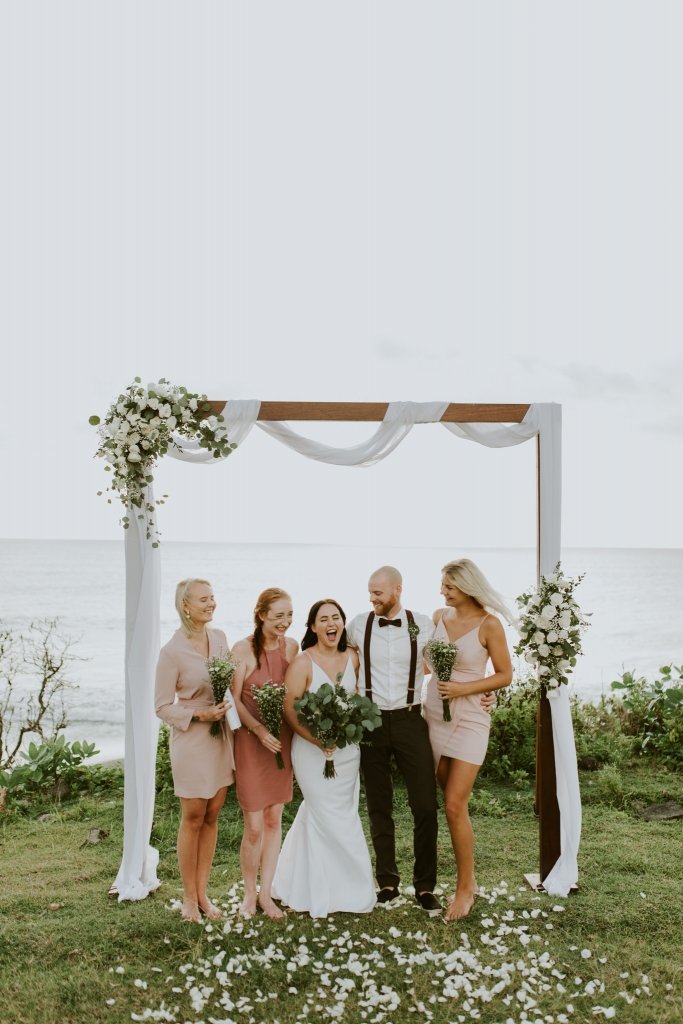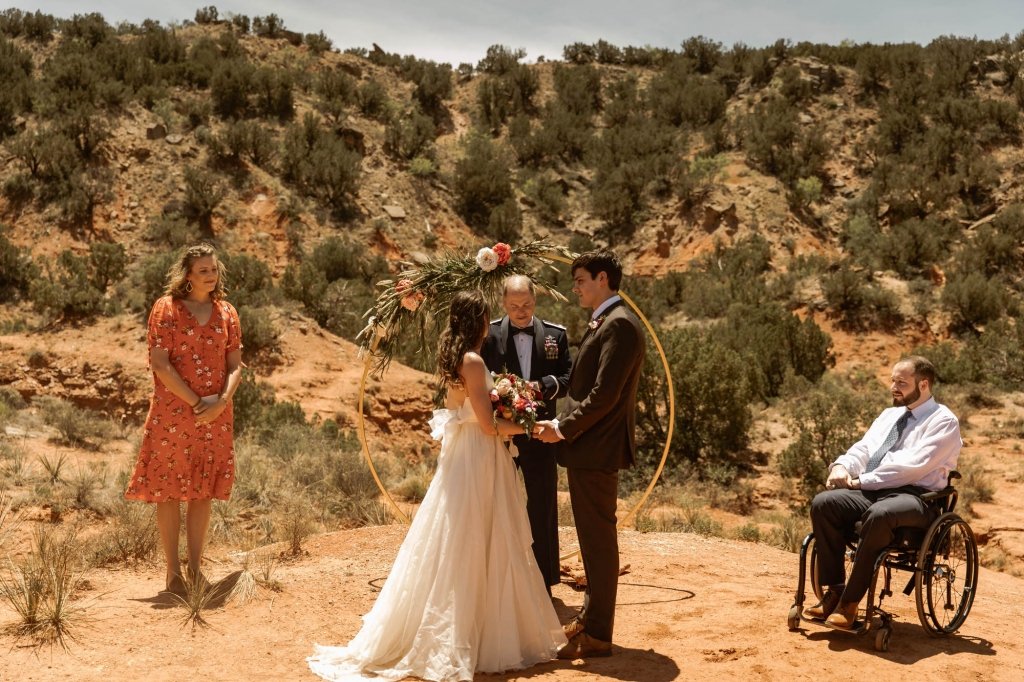How to Plan a Micro Wedding + Our Favorite Micro Wedding Ideas
You’re probably thinking, what is a micro wedding? What is an elopement? What is a minimony? How am I going to decide which one to have? With more couples learning what it means to elope, comes more couples looking to plan an intimate wedding day experience. We are here to tell you you’re not alone. Couples around the world are changing their wedding plans. From postponed wedding dates to couples who throw their hands up in the air and say, “let’s just do this damn thing!”.
Planning a micro wedding is the perfect way to include your closest friends and family AND still have an intimate experience together. Let’s dive into the main differences between a traditional wedding, micro wedding, minimonys, and elopement.
This is a detailed guide to help you plan your micro wedding. Jump to the section you’re most interested in:
- What is a Micro Wedding?
- How Much Does a Micro Wedding Cost?
- What is the Difference Between a Micro Wedding, Elopement and Minimony?
- How to Plan a Micro Wedding
- Micro Wedding Ideas to Inspire You
What is a Micro Wedding?

Photo by FIRE, WOOD & EARTH
A micro wedding is a smaller version of a traditional wedding with no more than 40 guests. The wedding ceremony and reception of a micro wedding are also much smaller, intimate, and less extravagant than a traditional wedding. However, a wedding ceremony during a micro wedding usually follows the same traditions bigger weddings follow.
So should you plan a micro wedding this year? If you want an intimate experience and if you’re looking to save money, then a micro wedding is definitely the way to go. A micro wedding allows you to have all the trimmings of a traditional wedding, without the big guest number attached to you. You can still do all the traditions you love, including having a loved one walk you down the aisle, cake cutting ceremony or even a garter toss if you’re into that type of thing!
How Much Does a Micro Wedding Cost?

Photo by Jason Thomas Crocker Photography
Micro weddings vary greatly in price depending on what the couple wishes to do. On average, for example, we have seen micro weddings cost anywhere from $2,000 to $15,000. The biggest things you’ll want to factor in your budget are your vendors, venue (if any), and food.
We love micro weddings because a lot of them are also considered elopements. While couples who elope have less than 20 guests, or no guests at all, planning an elopement and a micro wedding are pretty similar! We suggest you visit our guide to plan your micro wedding budget.
What is the Difference Between a Micro Wedding and an Elopement? What is a Minimony?
A micro wedding follows more of a traditional structure of a big wedding, but with fewer restrictions. An elopement doesn’t have to follow any traditional wedding structure and has virtually no restrictions.
Since we know what a micro wedding is now, what is a minimony? This term surfaced due to so many couples changing their original wedding plans because of COVID19. This global pandemic has allowed more couples to realize what elopements and micro weddings are, allowing them to create their own set of rules when wedding planning. A minimony is typically a commitment ceremony of their marriage union prior to their actual wedding day. A lot of couples who go this route are eloping and then having a wedding later!
How to Plan a Micro Wedding

Photo by Brit Nicole Photography
Planning a micro wedding can be as simple or as complex as you would like it to be. The beauty of planning your wedding day one of these ways is you both are prioritizing your union above guest lists, decorations, and flowers.
Planning a micro wedding can be fun, relaxing, and allow you to focus entirely on each other. So many couples don’t remember their wedding day. In many ways, this pandemic has taught couples the beauty of living in the moment together.
Here’s what you should consider when planning a micro wedding:
- Decide who you’re going to invite. Don’t feel overwhelmed by this step. Normally micro weddings are 40 people are less. If you want to keep things intimate and small, then stick to your immediate friends and family. Having a hard time picking who to invite? Consider eloping or planning a virtual ceremony. If you’re worried about what others will think, then check out these 5 tips for announcing your elopement.
- Where are you going to host your micro wedding? Your wedding can be wherever you want it to be. Think about the venue you want to have your ceremony. We have seen some pretty amazing backyard weddings and intimate Airbnb weddings. If you want to have an adventure together and include your guests, then we suggest checking out our top places to elope.
- Are you having a reception after? If you are planning a super intimate wedding ceremony, then consider inviting your guests to your reception instead. A micro wedding reception is a great idea to include a little more guests and celebrate together. Couples who elope opt to have a post elopement party to celebrate their union with family and friends at a later date.
- Put together your vendor list for your wedding. Did you know Wandering Weddings has members who specialize in planning and documenting elopements and small weddings around the world? Check out our vendors! If you’re interested in micro wedding packages, then our best advice is to search our directory or team up with an elopement photographer/planner to suggest other vendors you’ll need for your wedding.
Since micro weddings are so similar to elopements, check out our guide on how to elope, where we highlight the 7 steps you need to know when planning.
Micro Wedding Ideas to Inspire You

Photo by Adventure and Vow
Now that you know what a micro wedding is, are you ready for some amazing micro wedding ideas to inspire you? Explore these micro wedding stories below of couples who decided to plan a mini destination wedding adventure.
Are you thinking, “why elope instead of having a wedding?” Check out these reasons to elope.
Micro Wedding in Mesa, Arizona
These two planned an intimate micro wedding ceremony at the gorgeous superstition mountains in Arizona. For the ceremony, they found a private venue, overlooking the mountains. They were able to incorporate details from a traditional wedding in a more intimate way with their closest family and friends by their side.
Vendors:
Photography: Parker Micheaels Photography |Hair and Makeup: Blendid Skincare| Florals: Melissa Barela | Videographer: Joshua Coe | Dress: Madi Lane Bridal
Idaho Wedding Ceremony and Sunrise Adventure
This bride and groom incorporated their religious background and love for nature during their wedding day. They woke up at 4 AM to hike near Payette Lake in Idaho for their first look. Then they met their family for a midmorning ceremony with elements from both their Catholic and Jewish backgrounds.
“An indoor venue was never really a consideration for either of us. Our vision of our perfect eternal moment would be one where we’re outside, under the sky, surrounded by plants. So when we had the opportunity to ‘be in charge for the day,’ we wanted to be in a place where we felt most relaxed and comfortable, which is in the mountains and woods with friends and family…
I am Jewish and Ben grew up Catholic. Judaism is an important part of my identity, but we prioritized making sure that both sides of our family felt included and equally a part of the celebration. Our approach was to weave Jewish traditions into a very relaxed, contemporary ceremony.” [Micah, the bride]
Vendors:
Photography: Autumn Lynne Photography | Planning/Styling: Dreamer Events | Wedding Dress: BHLDN
Adirondack Mountains Micro Wedding Ceremony in New York
After changing their wedding destination multiple times, these two planned an intimate wedding ceremony with their closest family members. After saying their I do’s, Ashlee and Caine hiked up the mountain for the most stunning views.
“They were supposed to elope in Montana at Glacier National Park, but unfortunately, with covid preventing that, we had to brainstorm ideas for a new location. We decided to change it to Tennessee and when that didn’t work, North Carolina. We were hit with new travel restrictions so many times that we had to rethink the location once again! With the Adirondack Mountains basically in our backyard (6 hours,) we figured that would be the best option. Two weeks before the elopement, Ashlee told me that they were also expecting a baby! Nothing about their elopement went according to plan, but it turned out absolutely AMAZING.” [Emily, the photographer]
Vendors:
Photography: Basically Emily | Second Shooter: Cari Hughes Photography | Flowers: Drift Floral | Hair and Makeup: The Painted Pair
Micro Wedding at Home in Santa Fe, New Mexico
This couple purchased a home in Santa Fe but still lived in New York, where they both work. When the pandemic hit, a month after they became engaged, these two moved into their Santa Fe home to get away from the big crowds. While there, they decided an elopement would be the best option for them. They explored their gorgeous property, and watched the sunset from a hill by their driveway!
Vendors:
Photography | Wild Coast Photography
A Vintage elopement at the Superstition Mountains, Arizona
This couple wanted their wedding day to represent the style they loved. After postponing their wedding day, they didn’t want to risk pushing their special day even further.
They planned a vintage micro wedding in the gorgeous Superstition Mountains in Arizona. They bought a vintage car, drove all the way to this epic destination. Their two friends and son were witnesses to their intimate ceremony.
“It was more than just something good enough for the time being, It was meant to be the entire time. Everything fell into place as though the plans were set all along, and we were exactly where we were supposed to be in each moment.
We have quite honestly forgotten about our traditional wedding plans. We shared the video of the ceremony with our loved ones, and they were able to have this moment with us no matter the distance. ” [Megan, the bride]
Vendors:
Videography: Archie Film Co.
Sedona, Arizona Micro Wedding Dream
When it comes to wedding planning frustration, Kamaile and Ash are familiar with it. These two replanned their wedding 3-4 times, first due to COVID, and then they postponed their wedding due to wildfires in Arizona.
They ended up eloping in Sedona!
They were able to incorporate Hawaiian wedding traditions, their immediate family and friends, and an epic sunset!
“Our elopement day was perfect; our schedule was flexible, we were relaxed, and our handful of guests were mesmerized by the scenic backdrop. While so many of my friends say their wedding day passed in a flash and express disappointment that they couldn’t spend more time with each guest or truly enjoy their festivities, we spent our entire day totally tuned in to each other. Holding hands, taking in breathtaking views, and laughing with our best friends.
It wasn’t the wedding I had dreamed of, but it became something I never even knew I so deeply wanted.
You can tune out all the wedding stuff, and tune in to your love, ground in a special place, and connect deeply with whomever you choose to witness. Not to mention, you can start your marriage without crushing wedding costs/debt. Our day was truly connected, beautiful, and memorable. Having planned it 4 times, I can say with confidence that I wouldn’t have had it any other way!” – [Kamaile, bride]
Vendors:
Photography: Adventure and Vow | Kamaile’s Jumpsuit and Ash’s Suit: ASOS |Flowers: Sedona Fine Art of Flowers |Videographer: Cam & Beck |Kamaile’s Ring: Mountain Momma Gems | Ash’s Ring: Etsy |Hair/MU: Seventh Ave Beauty
Airbnb MicroWedding in Santa Rosa, California
Jenn and Michael decided to have an Airbnb wedding in Santa, Rosa California. This 1900s home was the perfect venue for their small wedding. These two even had a virtual wedding invite for the family who couldn’t be invited due to restrictions.
After their ceremony, they ordered dinner from a local Italian restaurant and celebrated with sunset wedding portraits. The couple plans to hold a post elopement reception with their family and friends in the following year or so.
Vendors:
Photography: Autumn Agrella
White Mountains of New Hampshire Elopement Adventure
If you’re frustrated with wedding planning, then a micro wedding adventure may be just for you! Why?
You’re able to truly enjoy your wedding day without any distractions, and you’re able to plan an epic adventure.
Lauren and Corey were frustrated after their larger wedding plans got canceled. Instead of postponing and planning another wedding day, these two decided to elope with their closest friends. They also planned a bigger celebration later on, but they couldn’t wait any longer! We wouldn’t either.
Vendors:
Photography: Kelsey Converse | Florists: DG Flower Studio | Officiant: Jean Lee
Joshua Tree National Park Elopement With Friends
Liz and Addison planned an intimate elopement at Joshua Tree National Park on their original day with their closest friends.
“Our wedding day wasn’t what we had planned, but the desert elopement was better than anything we had imagined. Our beautiful friend and spiritual mentor officiated our civil union and personalized every aspect of it.
We were also able to recite vows we had written ourselves, whereas in a traditional Catholic church ceremony you must recite the church vows; so that was very special to us, and something we will remember forever.” [Liz, the bride]
Vendors
Photography: Jason Thomas Crocker Photography |Airbnb: High Desert Paradise | Flowers: Of The Flowers |Cake: Funfetti with cookie dough filling from Butter Cake Shoppe |Cake topper, Succulents, Gift Bags, Ring Box: Etsy Brides Frist Look – Wedding rings: Custom Lauren B Jewelry|Dress: For Love and Lemons| Shoes: Me too | Necklace: Dylanlex |Bracelets: Vita Fede |Hat: Wyeth|Fringe Jacket: Desigual Groom’s First look –Wedding band: Custom Lash Brooke | Groom’s Attire: Express |Shoes – Ted Baker
Virtual Wedding Ceremony at a California Airbnb
Tiffany and Kevin were heartbroken when they learned they had to postpone their wedding due to the pandemic. After brainstorming with their photographer, these two loved the idea of eloping and then celebrating the following year.
In a way, planning an elopement and a post elopement reception is the best of both worlds!
Instead of a fancy venue, these two rented an adorable and intimate Airbnb in California where they had a live stream wedding ceremony with their closest family and loved ones.
These two even got married on national donut day, so it was only fitting to celebrate their marriage with champagne and donuts.
After their ceremony, these two explored the coast and mountains throughout Malibu. They even had their first dance as the sunset.
“With the crickets chirping, breeze flowing through their hair and their favorite song playing on a small speaker, they danced their first dance.
It was absolutely beautiful, meaningful, and perfect. It reflected them in the most wonderful way. Despite plans changing throughout 2020, they couldn’t imagine it any other way.” [Karissa, the photographer]
VENDORS:
Photography: Wildflower Photo Co. | Videography: Wildflower Photo Co.
Florist: Love Stuck Blooms |Dress: Lulus | Hair & Makeup: Jeanne San Diego | Donuts: Donut Friend |
Elopement Adventure Near Breckenridge
Megan and Colin postponed their wedding to the following year but decided a minimony was best for them. Their intimate elopement was the perfect adventure to share their vows and celebrate their marriage.
Paige, their photographer, scouted a secret location for them to hike to, and their only request on their elopement day was… “We want to hike and drink beer!”
It doesn’t get better than that!
Vendors: Paige Weber Photography
Romantic Italy Elopement in Rochemolles
Federica and Lorenzo share a passion for nature and the mountains, so it was only fitting to celebrate their union at Rochemolles, a beautiful hidden gem in Piedmont Alps.
Their private ceremony was under the rain, near the waterfalls. They danced, they cried, they made a toast, and above all, they had fun together.
Vendors:
Photography: Ludovica & Valerio | Venue: Rifugio Scarfiotti |Wedding Dress: Elena Pignata Bridal |Flowers: Mutabilis Lab |Styling: Chiara Viarisio
Small Wedding at Palo Duro Canyon
A great idea for your micro wedding is to combine concepts from both a wedding and elopement in one. Rebekah and David started their epic wedding day at 4 AM to hike to get some epic sunrise portraits.
Imagine having your first look next to an over 100-foot cliff with a bandana over your eyes! These two enjoyed exploring this epic canyon together and then had a romantic ceremony with their family.
“Our original large wedding was canceled/postponed due to COVID, and getting to spend an entire morning with just us and family in an intimate wedding was very fitting for our relationship. Family will always be a special part of our lives.
My favorite part has to be cold calm quiet morning in a Jeep ride down some sketchy paths just to hear what we swear was a mountain lion.
We stared at the stars, just waiting for the sunrise. The peace, the anticipation, the coolness, and the laughs. It’s got to be what the best parts of marriage will feel like.” [Rebekah, the bride]
Vendors:
Photography: Brit Nicole Photography, Arch provided by Brit Nicole Photography|Florist: Parie Designs | Wedding Dress: Blue Bridal in Austin Texas |Tie: DAZI | Rings- Adiamor Diamonds and Manly bands |Palo Duro Canyon Private Property + State Park
Micro Wedding in Canggu, Bali
Josefin and David traveled all the way from Sweden to Bali for their intimate wedding day. Despite their advanced plans, these two received news that Josefin’s father passed away just before their wedding day.
Despite having to cancel their trip after their actual ceremony, these two made the best of their day with a simple and romantic ceremony, where Josefin’s 3 best friends tagged along.
Vendors:
Photography by FIRE, WOOD & EARTH
Mount Baker Elopement with Best Friends and Puppy
These two were overwhelmed with wedding planning during the pandemic. Instead of trying to figure out what to do and putting their marriage off any longer, these two eloped at gorgeous Mount Baker National Forest together.
Their micro wedding was very intimate, simple, and beautiful. Their two best friends joined them, along with their adorable pup! They even made it a priority to include their loved ones through a live stream call.
Changing your wedding plans can be emotional, but so many couples are loving the intimacy and romance of eloping together.
Vendors:
Photography by Outshined Photography

Photo by FIRE, WOOD & EARTH












































